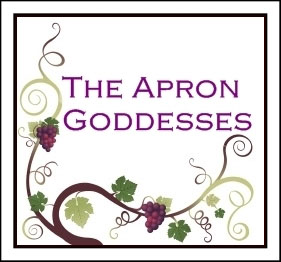Wednesday, February 24, 2010
MY BIRTHDAY PRESENTS
Sunday, February 7, 2010
BluSkies Spring Onion Crackers in Retro Tin
 * Description from BluSkies.com
* Description from BluSkies.comEnjoy the delightfully crisp bite of the first and original BluSkies Spring Onion Crackers. Made with real spring onion chives and freshly roasted sesame seeds for that enjoyable taste that you are looking for in a healthy snack. BluSkies Spring Onion Crackers is so inbiteing, it’s delicious on its own! BluSkies Spring Onion has 0% cholesterol so you can enjoy the TASTE without the WAIST!
These crackers are imported from the Philipines. I found them at Hong Kong Market and really bought them because of the tin can they come in. Very retro ,it reminded me of the tins I grew up seeing in my Aunt Lee's pantry.
The crackers are very mild, they have delicate taste and I love them with butter and soup.
Thousand Year Old Eggs


Preserved Duck Eggs
Century egg, also known as preserved egg, hundred-year egg, thousand-year egg, and thousand-year-old egg, is a Chinese cuisine ingredient made by preserving duck, chicken or quail eggs in a mixture of clay, ash, salt, lime, and rice hulls for several weeks to several months, depending on the method of processing. After the process is completed, the yolk becomes a dark green, cream-like substance with a strong odor of sulphur and ammonia, while the white becomes a dark brown, transparent jelly with little flavor or taste. The transforming agent in the century egg is its alkaline material, which gradually raises the pH of the egg from around 9 to 12 or more. This chemical process breaks down some of the complex, flavorless proteins and fats, which produces a variety of smaller flavourful compounds.
Some eggs have patterns near the surface of the egg white that are likened to pine branches.
Some eggs have patterns near the surface of the egg white that are likened to pine branches.
Production
The origin of the method for creating century eggs likely came about through the need to preserve eggs in times of plenty by coating them in alkaline clay, which is similar to methods of egg preservation in some Western cultures. The clay hardens around the egg and resulted in the curing and creation of century eggs instead of spoiled eggs.
According to some the century egg has over five centuries of history behind its production. Its discovery, though not verifiable, was said to have occurred during the Ming dynasty 600 years ago in Hunan, when a home owner discovered duck eggs in a shallow pool of slaked lime that was used for mortar during construction of his home 2 months before. Upon tasting the eggs he set out to produce more, this time with the addition of salt to improve this taste, thus resulting in the present recipe of the century egg
Traditional
Century egg coated in a caustic mixture of mud and rice husk
The traditional method for producing century eggs is a development and improvement from the aforementioned primitive process. Instead of using just clay, a mixture of wood ash, quicklime, and salt is included in the plastering mixture, thereby increasing the pH and sodium content of the clay mixture. This addition of natural alkaline compounds improved the odds of creating century eggs instead of spoilage and also increased the speed of the process. A recipe for creating century eggs through this process starts with the infusion of three pounds of tea in boiling water. To the tea, three pounds of quicklime (or seven pounds when the operation is performed in winter), nine pounds of sea-salt, and seven pounds of wood ash from burned oak is mixed together into a smooth paste. Each egg is then individually covered by hand, with gloves being worn to prevent the corrosive action of the lime on skin. Each egg is then rolled in a mass of rice chaff to keep the eggs from adhering to one another before they are placed in cloth-covered jars or tightly woven baskets. In about three months, the mud slowly dries and hardens into a crust, and then the eggs are ready for consumption.
Century egg coated in a caustic mixture of mud and rice husk
The traditional method for producing century eggs is a development and improvement from the aforementioned primitive process. Instead of using just clay, a mixture of wood ash, quicklime, and salt is included in the plastering mixture, thereby increasing the pH and sodium content of the clay mixture. This addition of natural alkaline compounds improved the odds of creating century eggs instead of spoilage and also increased the speed of the process. A recipe for creating century eggs through this process starts with the infusion of three pounds of tea in boiling water. To the tea, three pounds of quicklime (or seven pounds when the operation is performed in winter), nine pounds of sea-salt, and seven pounds of wood ash from burned oak is mixed together into a smooth paste. Each egg is then individually covered by hand, with gloves being worn to prevent the corrosive action of the lime on skin. Each egg is then rolled in a mass of rice chaff to keep the eggs from adhering to one another before they are placed in cloth-covered jars or tightly woven baskets. In about three months, the mud slowly dries and hardens into a crust, and then the eggs are ready for consumption.
Modern
Century egg showing snow-flake/pine-branch(松花)–like patterns
Even though the traditional method is still widely practiced, modern understanding of the chemistry behind the formation of century eggs has led to many simplifications in the recipe. For instance soaking the eggs in a brine of salt, calcium hydroxide, and sodium carbonate for 10 days followed by several weeks of ageing while wrapped in plastic is said to achieve the same effect as the traditional method. This is true to the extent that egg curing in both new and traditional methods is accomplished by introducing alkali hydroxide ions and sodium into the egg.
Although poisonous, lead (II) oxide is also known to increase the curing speed of century eggs, leading some less scrupulous century egg producers in the past to add it to their curing mixtures. However, zinc oxide is now used as a safer alternative. Although zinc is an essential micronutrient, one needs to bear in mind that it can lead to a copper deficiency, so the zinc content needs to be checked for safety.
Use
Arranged century egg on a plate
Century eggs can be eaten without further preparation, on their own as a side dish. As an hors d'œuvre, the Cantonese wrap chunks of this egg with slices of pickled ginger root (sometimes sold on a stick as street food). A Shanghainese recipe mixes chopped century eggs with chilled tofu. In Taiwan it is popular to eat century eggs on top of cold tofu with katsuobushi, soy sauce, and sesame oil in a style similar to Japanese Hiyayakko. A variation of this recipe common in northern China is to slice century eggs over chilled silken (soft) tofu, adding liberal quantities of shredded young ginger and chopped spring onions as a topping, and then drizzling light soy sauce and sesame oil over the dish, to taste. They are also used in a dish called old-and-fresh eggs, where chopped century eggs are combined with (or used to top) an omelet made with fresh eggs.
Some Chinese households cut them up into small chunks and cook them with rice porridge to create Century egg and Lean Pork congee (Chinese: 皮蛋瘦肉粥; pinyin: pídàn shòuròu zhōu). This is sometimes served in dim sum restaurants. Rice congee, lean pork, and century egg are the main ingredients. Peeled century eggs are cut into quarters or eighths and simmered together with the seasoned marinated lean slivers of pork until both ingredients are cooked into the rice congee. Fried dough sticks known as youtiao are commonly eaten with century egg congee. Another common variation of this dish is the addition of salted duck eggs into the congee mixture.
On special events, like wedding banquets or birthday parties, a first course platter of sliced barbecued pork, pickled baby leeks, sliced abalone, pickled Julienned carrots, pickled julienned daikon radish, seasoned julienned jellyfish, sliced pork, brawn and the quartered century eggs is served. This is called a lahng-poon in Cantonese, which simply means cold dish.
A popular street food in Hong Kong consists of whole century eggs coated in fish meal, breaded, and deepfried, producing a snack analogous to the ubiquitous Scotch egg in the United Kingdom.
Arranged century egg on a plate
Century eggs can be eaten without further preparation, on their own as a side dish. As an hors d'œuvre, the Cantonese wrap chunks of this egg with slices of pickled ginger root (sometimes sold on a stick as street food). A Shanghainese recipe mixes chopped century eggs with chilled tofu. In Taiwan it is popular to eat century eggs on top of cold tofu with katsuobushi, soy sauce, and sesame oil in a style similar to Japanese Hiyayakko. A variation of this recipe common in northern China is to slice century eggs over chilled silken (soft) tofu, adding liberal quantities of shredded young ginger and chopped spring onions as a topping, and then drizzling light soy sauce and sesame oil over the dish, to taste. They are also used in a dish called old-and-fresh eggs, where chopped century eggs are combined with (or used to top) an omelet made with fresh eggs.
Some Chinese households cut them up into small chunks and cook them with rice porridge to create Century egg and Lean Pork congee (Chinese: 皮蛋瘦肉粥; pinyin: pídàn shòuròu zhōu). This is sometimes served in dim sum restaurants. Rice congee, lean pork, and century egg are the main ingredients. Peeled century eggs are cut into quarters or eighths and simmered together with the seasoned marinated lean slivers of pork until both ingredients are cooked into the rice congee. Fried dough sticks known as youtiao are commonly eaten with century egg congee. Another common variation of this dish is the addition of salted duck eggs into the congee mixture.
On special events, like wedding banquets or birthday parties, a first course platter of sliced barbecued pork, pickled baby leeks, sliced abalone, pickled Julienned carrots, pickled julienned daikon radish, seasoned julienned jellyfish, sliced pork, brawn and the quartered century eggs is served. This is called a lahng-poon in Cantonese, which simply means cold dish.
A popular street food in Hong Kong consists of whole century eggs coated in fish meal, breaded, and deepfried, producing a snack analogous to the ubiquitous Scotch egg in the United Kingdom.
According to Harold McGee soaking eggs in a 5% sodium chloride, 4.2% sodium hydroxide solution for 8 days and then cooking at 70 degrees Celsius for 10 minutes "Nouveaux Pidan Eggs" can be made, these have a set yellow yolk and colorless white. If the solution is too alkaline or is left a few days longer then the white can become tea colored, but still transparent and the yolk get hints of green as the reactions caused by the alkali go further towards a standard pidan egg.
Myth
According to a persistent myth, century eggs are, or once were, prepared by soaking eggs in horse urine. The myth may arise from the pungent odor of ammonia given off by century eggs, which is reminiscent of urine. Horse urine itself, however, is only slightly basic, ranging in pH from 7.5 to 7.9. Though human urine left standing can reach a maximum pH of around 9.4—the same as a 1-molar solution of ammonia—it is still less than that produced by mixing quicklime (calcium oxide) or wood ash in water.
In Thai and Lao, the common word for this type of preserved egg literally means "horse urine eggs", either due to this myth or the distinctive ammoniac odour of century eggs:
* from Wikipedia
How are century eggs eaten?
You can just crack the shell, slice the eggs and enjoy them with your favorite dipping sauce. Soy sauce and vinegar with a little ginger is a popular accompaniment or soy sauce an sesame oil. Or serve on a plate of hors d’œuvre with sliced roast duck, suckling pig and char siu pork. You can add them to salads and congee too.
Many say that the appreciation of century eggs is something acquired. I say just keep an open mind.
Many say that the appreciation of century eggs is something acquired. I say just keep an open mind.
The Appearance
It looks like a hard-boiled egg.
The egg white that has turned a deep transparent brown hue and has a gelatinous texture .It looks like brown jello.
The yolk was no longer yellow but a Blackish -Gray mass with a creamy texture that is sticky and pasty towards the center.
The Smell
To me it had a mild fishy smell
The Taste
Really it just tasted like a hard boiled egg.
The Test
I had several friends over and tried to get them to try a sliced egg.
No one had to guts to try it.
Youtube.Com
Youtube has several crazy videos of people attempting to try and eat these eggs. They really aren't as bad as these folks are making out, once you get past the appearance and the smell.
Wednesday, February 3, 2010
MAMA'S DIRTY DOG
ADORABLE LITTLE FACE
 EVEN THOUGH SHE JUST HAD A BATH
EVEN THOUGH SHE JUST HAD A BATH AND WENT AND PLAYED IN THE MUD
 WHAT A DIRTY DOG
WHAT A DIRTY DOG
 WHAT A DIRTY DOG
WHAT A DIRTY DOGMonday, February 1, 2010
MARKET LUNCH
 Sometimes its just easiest to pick up a few things at the Market deli.When I spend the morning running errands ,grocery shopping and doing extra work. I am hungry when I get home and usually want to eat right then, so these great pick me ups are just the ticket.
Sometimes its just easiest to pick up a few things at the Market deli.When I spend the morning running errands ,grocery shopping and doing extra work. I am hungry when I get home and usually want to eat right then, so these great pick me ups are just the ticket. For a quick lunch.
 Triple peppercorn pork liver pate
Triple peppercorn pork liver pate

This is the size of a donut, very good flavor
Subscribe to:
Posts (Atom)












































